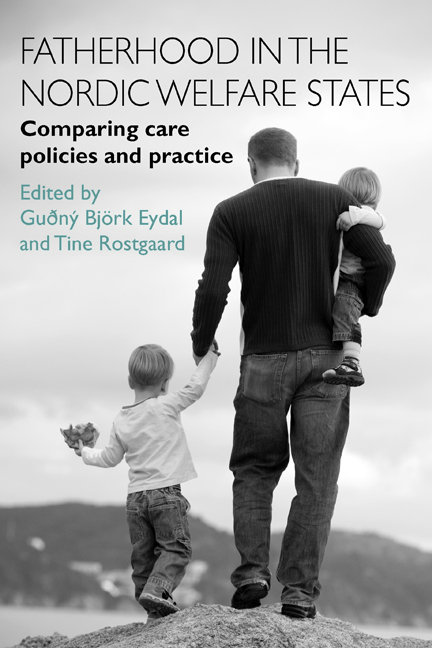Book contents
- Frontmatter
- Contents
- List of tables and figures
- Notes on contributors
- Acknowledgements
- one Introduction
- Theme 1 Fathers, families and family policies
- Theme 2 Fathers in everyday life – culture, work and care
- Theme 3 Constructing fatherhood in different family settings
- Theme 4 Caring fathers and paid parental leave policies
- Theme 5 International reflections on findings
- Conclusions
- Index
six - Parental leave and classed fathering practices in Norway
Published online by Cambridge University Press: 04 March 2022
- Frontmatter
- Contents
- List of tables and figures
- Notes on contributors
- Acknowledgements
- one Introduction
- Theme 1 Fathers, families and family policies
- Theme 2 Fathers in everyday life – culture, work and care
- Theme 3 Constructing fatherhood in different family settings
- Theme 4 Caring fathers and paid parental leave policies
- Theme 5 International reflections on findings
- Conclusions
- Index
Summary
Introduction
This chapter deals with fathers’ care practices in relation to parental leave. From an international perspective, Norway and the other Nordic countries offer extensive parental leave schemes to families in order for them to be able to practice parenting in more gender-equal ways. Subsequently, many Nordic studies have provided evidence indicating a shift towards the increased involvement of fathers in everyday life with children (Bekkengen, 2002; Brandth and Kvande, 2003a; Lammi-Taskula, 2007; Aarseth, 2008, 2011; Eydal, 2008; Forsberg, 2010; Klinth and Johansson, 2010).
An important question when assessing the benefits of parental leave for fathers is how they actually spend their time when on such leave. Previous research has focused on differences in how fathers use parental leave depending on their working conditions, family life and parental leave length (Brandth and Kvande, 2002, 2003a, 2003b). As O’Brien (2009) has pointed out, however, more knowledge on this question is still required, particularly concerning what fathers actually do when on leave. In recent decades, the concept of the ‘new father’ has gained cultural status in the Nordic countries, indicating that traditionally gendered parental roles have changed notably and created more dual earner/dual carer families. This dominant fathering discourse has been found to represent a middle-class conception of ‘good parenting’ and how parental leave should be used (Stefansen and Farstad, 2008). It has been argued that middle-class economic, cultural and social capital is often projected as a standard example for parents to follow (Gillies, 2005, p 850). Conversely, studying the class dimension of Norwegian childcare policies, Ellingsater (2012) shows that these policies have reduced class differences over time. Most fathers use their individual leave rights; only the length of the leave shows class-related variations in the statistics.
This chapter addresses variations in fathers’ leave use. Earlier research has shown how various time cultures in working life explain variations in how parental leave is used (Brandth and Kvande, 2003a, 2005). Here, class and gender are brought into the unpacking of fathers’ care practices. The analysis contains two parts. First, class differences in parental leave take-up are explored. The second part concerns what fathers do when home on parental leave.
- Type
- Chapter
- Information
- Fatherhood in the Nordic Welfare StatesComparing Care Policies and Practice, pp. 121 - 140Publisher: Bristol University PressPrint publication year: 2014



